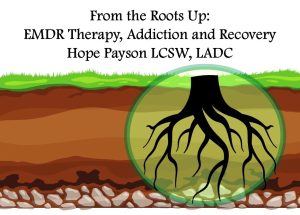Home Study!
Can’t attend an in-person training? I am now offering 3 on-demand home study options, so you can learn at home at your own pace.
The 12 hour option–The Power Of The Pain, is a deep dive into the use of EMDR therapy with individuals who struggle with addiction. This is not a recording of a past training, it is a series of carefully made videos specifically for study at home. It includes scripted handouts, group demonstration opportunities, video examples of addiction protocols in use, and interviews with EMDR/Addiction experts who offer advice on how to help clients in a wide variety of treatment settings.
The 6 hour option–From the Roots Up: EMDR Therapy, Addiction and Recovery is a recording from a live training with 5 talented guest speakers, who address common questions about working with individuals who struggle with addiction in a variety of treatment settings. This training focuses more on the use of the standard EMDR Therapy approach using slight modifications in the Phase Three questions to address the triggers, urges and feeling states connected to past compulsive behavior.
The 3 hour option–EMDR, Addiction and Recovery offers a good overview of how to assist this population and provides clear treatment planning suggestions. All options include both CE’s and EMDRIA Credits.
The Power of the Pain: EMDR Therapy, Addiction and Recovery

with Hope Payson LCSW, LADC and other EMDR/Addiction experts who work in a variety of settings
This 12 CE workshop gives special consideration on how to use EMDR therapy in all stages of change and strategies that can be used to address motivational and stabilization challenges.
LEARNING OBJECTIVES—PARTICIPANTS WILL BE ABLE TO:
- Articulate how trauma symptoms increase vulnerability to addiction.
- Identify interventions that can be used in each stage of change
- Understand how motivational interviewing questions can be used in EMDR therapy.
- Identify at least 2 addiction specific stabilization options to use in Phase 2 of EMDR therapy.
- Describe the steps involved in addressing and desensitizing cravings, urges and triggers related to substance/behavioral addictions.
- Define the term: maladaptive positive feeling state.
- Identify how to address the maladaptive “positive” feelings, body sensations or irrational cognitions linked to addictions.
- Identify treatment planning options, and common NC/PC’s for clients with histories of complex trauma and addiction.
Click the button below for a link to this training:

From the Roots Up: EMDR Therapy, Addiction and Recovery
(6 CEs) This 6 CE workshop is a recording from a live training that includes 2 Q & A sessions and panel discussions with a variety of EMDR/Addiction Experts. This training focuses on case conceptualization and the use of both Addiction-Focused EMDR and Trauma-Focused EMDR. It provides a scripted handout of the standard Phase Three approach with slight modifications that can be used to address the triggers, urges and feeling states related to past compulsive behaviors.
LEARNING OBJECTIVES—PARTICIPANTS WILL BE ABLE TO:
Describe how trauma symptoms increase vulnerability to addiction.
Describe the impact of adverse childhood and community experiences and how this can be used to inform the treatment planning process.
Identify at least 2 addiction specific stabilization options to use in Phase 2 of EMDR therapy.
Identify what to look for when determining when someone is “stable enough” to proceed past Phase 2 of EMDR Therapy.
Describe when and how to use harm reduction principles within the EMDR Therapy process.
Describe how to identify and address cravings, urges and triggers related to substance/behavioral addictions using the standard EMDR Therapy, 8 phase, 3 prong approach.
Explain the term: maladaptive positive feeling state and its connection to addictive behaviors.
Identify how to address the maladaptive “positive” feelings, body sensations or cognitions linked to addictive behavior.
Describe when addressing underlying trauma using Standard Protocol EMDR would be appropriate.
Explain how to apply EMDR therapy to address common treatment barriers.
Click the button below for a link to this training:
EMDR, Addiction and Recovery
(3 CEs) This three hour course explains how an AIP lens can inform treatment planning for addictive behaviors. It also addresses resourcing needs and treatment barriers for individuals with substance use and behavioral addictions.
LEARNING OBJECTIVES—PARTICIPANTS WILL BE ABLE TO:
- Identify the factors that increase vulnerability to substance use disorders and behavioral addictions.
- Describe at least two Phase 2 resourcing options for individuals with histories of addiction
- Identify the treatment planning options for clients who struggle with addiction
- Explain how to use EMDR Therapy with persons who struggle with substance use disorders and behavioral addictions.